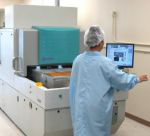
Manufacturers of flexible circuits use several chemical processes for fabrication. These processes are generally located in a common area of the plant because of facility requirements and environmental considerations. These chemical operations are referred to as wet processes. Some of the specific processes that would be characterized as wet process in circuit fabrication:
Develop-etch-strip: Photosensitive resist is developed so the unneeded resist is washed away, leaving a pattern of resist that defines the circuitry. The subsequent etching operation removes the base metal (normally copper) that has been exposed by the patterned resist. The last step is to remove (strip away) the resist that defined the circuitry.
Copper plating: This is typically an electro-chemical operation. Metal is electrodeposited onto the base metal surface thereby creating a thin, robust coating. Electroplating of copper is the most common example and is used to create electrical connection between traces on the top and bottom of the insulating dielectric film.
Shadow plating: A laminate of metal-dielectric-metal is initially drilled, punched, or laser ablated to form the vias. In order to initially create an electrical connection between the layers of metal, the dielectric must be coated with a conductive material. Shadow plating coats graphite inside a via and is a chemical process commonly used by flexible circuit manufacturers.
Each of these operations relies on chemical reactions, which may be supplemented with mechanical agitation, temperature and voltage/current. In most cases the chemical makeup is the most critical element that affects the output. It is vital that critical process parameters are tightly controlled to assure desired results. The following are the basic outputs that are monitored and compared to a process or customer specification:
Trace width and spacing
Metal thickness
Via integrity
Metal composition